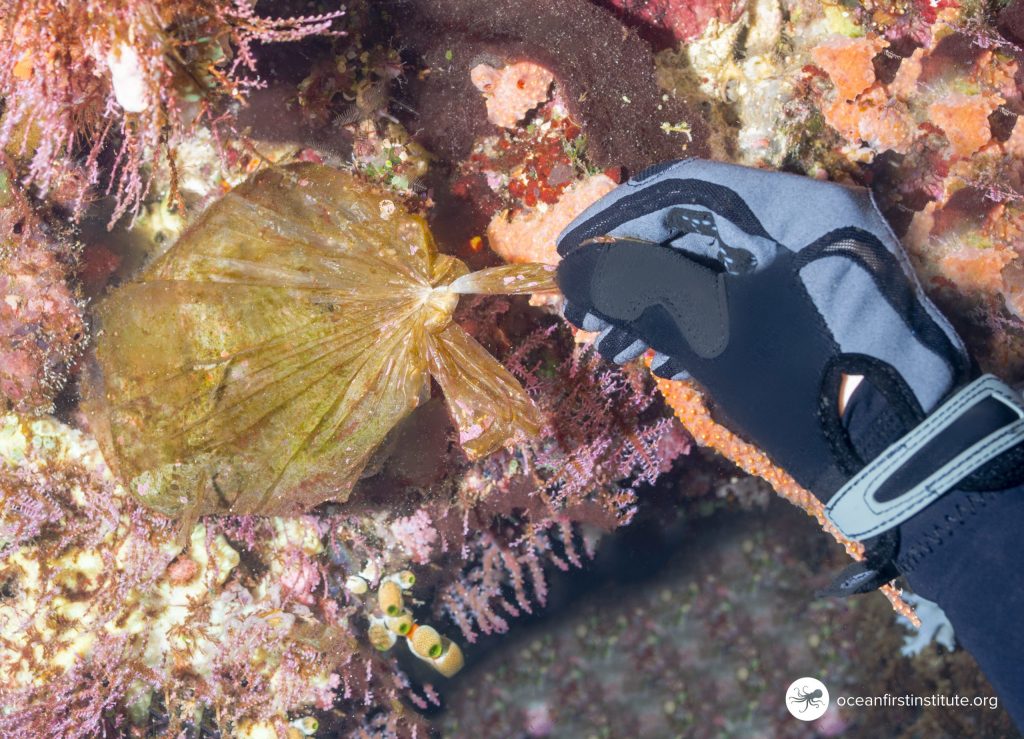A post by Kaela Loriz, Ocean First Institute Communication and Outreach intern.
Sooner or later, we will have to recognize that the Earth has rights, too, to live without pollution. – Evo Morales
The ocean connects us all, and every single community on the planet has the ability to positively impact water and ocean health in one way or another…and that’s pretty awesome and exciting! Two of the easiest and most productive steps that we can all take to promote a healthy ocean is to keep plastic out of our water and reduce our personal plastic use. In celebration of Plastic-Free July, we’ve got some statistics and solutions to bring out the ocean advocate in us all!

Our Ocean First Explorers get creative investigating how plastic pollution in the mountains impacts our fish species here and eventually those in the ocean. The materials used for this art project were all collected during a creek cleanup! Photo credit: Ocean First Institute
Ocean and plastic pollution facts:
- Over 500 million straws are used in the United States each day
- During the 2016 International Coastal Cleanup event, over 400,000 straws were collected worldwide
- Approximately 80% of all ocean pollutants can be traced back to land
- Most of this pollution is chemical in nature, stemming from agricultural practices and products that are damaging to the environment
- Avoiding plastic is important, but saying no to harsh lawn chemicals is the next step!
- Every year, humans create over 220 million tons of plastic
- Estimates from the United Nations Environment Program in 2006 concluded that there are approximately 46,000 pieces of plastic floating in every square mile of ocean
- Over 1 million seabirds and 100 thousand marine mammals die from plastic pollution every year
Microplastics and the process of plastic pollution:
We all know that macroplastic pollution is a big no-no. Large plastics can look like prey to marine animals who in turn eat the plastic. They can be a safety risk and obstacle to seafarers. They can trap small marine animals, and they’re eyesores. What happens to those plastic bottles over time? Through a process known as photo-oxidation or photo-degradation, the plastics are altered by UV light. The sunlight allows oxygen to interact with the plastic, making it increasingly brittle and prone to breakage. Eventually, the plastic is small enough to be ingested by small fish and, since plastic cannot be metabolized by fish, it moves up the food chain. While microplastic won’t necessarily kill a marine animal, it can cause serious illness and discomfort to our finned friends. Food for thought: we are at the top of that food chain, so it behooves us to keep plastics from entering it. There’s nothing quite like inadvertently ingesting some toxic material with your striped bass.
Another source of microplastic is the microbead. Microbeads are most commonly found as exfoliants in face scrubs, toothpastes, and soaps, but a bill banning their use in cosmetic products goes into effect this year. The ban was a huge step towards improved ocean health, but it still allows microbead use in detergents and a few other industrial products. Beginning in July of next year, this bill will completely ban the sale of personal care products containing microbeads in the United States!

We had a whale of a time making this beautiful soap. It’s free of harmful chemicals and plastic microbeads that threaten our ocean! Photo credit: Ocean First Institute
Solutions:
The best way to fight plastic pollution is to start at the source. Reducing plastic use is the best way to keep plastic out of our creeks, lakes, rivers, and ocean. These tips can help you ease into a plastic-free lifestyle and become the agent of positive change that the ocean needs!

BONUS Solution!
Join – or start your own – International Coastal Cleanup event on September 16th or any day! Completely eliminating plastic use is not realistic, but it doesn’t mean that we give up. Over 2,000 Coloradans participated in cleanups last September and there’s always room for more. By organizing our own creek, lake, and beach cleanups, we can be part of the solution!

Our Girls in Ocean Science campers, volunteers, and staff rounded up a whole bag of litter during our 30-minute creek cleanup. Imagine the positive impact YOUR cleanup could have! Photo credit: Ocean First Institute
Resources: UNESCO, Intergovernmental Oceanographic Commission, Pollution Solutions, NOAA, Ocean Conservancy, Lauren Riegler, Director of Outreach, Ocean First Institute

